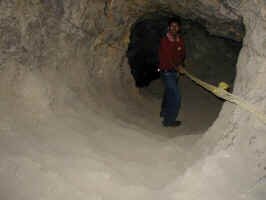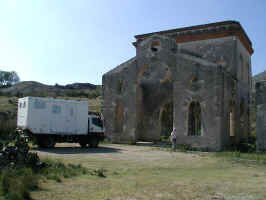October 28, 2004
We got an early start today so that we could visit the birthplace of Mexico’s independence, Dolores Hidalgo, on our way to the colonial town of San Miguel de Allende.
Dolores Hidalgo is the pueblo from which the local firebrand priest, Miguel Hidalgo, called on the local population to take back their country from Spain – launching the long war for independence. When we arrived in DH, we were pleased to find that it was market day. So we found a place to park and wandered through the market area. Although we weren’t in need of buying anything in particular, a stroll through a local market is always interesting.
We were surprised to find a number of stalls selling CD’s and DVD’s, although we could only find cassette players for sale. We did find ourselves drawn to a fruit vendor who was selling cups full of cut and peeled fruit with a topping of lime and chili powder. After only a moment of hesitation we dived in and bought the largest size he had available – and boy was it tasty, and no after effects.
We then walked through town to the main square where Hidalgo made his speech. The town is really sprucing itself up as it appeared that most of the buildings had received a recent coat of colorful paint. On the Zocalo we found vendors selling another treat that the town is known for – handmade ice cream. So of course we bought some, and yes it is very tasty. Old standby flavors like chocolate and vanilla, and exciting flavors like cactus, corn, beer and tequila among many others.
After wandering the streets and looking in the shops that sell Talavera pottery, we headed out of town. Just north of San Miguel de Allende we turned off the highway to check out a church that is the destination of pilgrims from around Mexico. It also holds a place in the story of independence as Hidalgo and Allende took the church’s banner as their flag. The Sanctuario de Atotonilco was built in 1740 as a spiritual retreat and is listed as one of the 100 most endangered places in the world.
The ceiling looked like something from the Sistine Chapel. The magnitude of the paintings and the devotion was overwhelming. Fortunately, something is being done to restore the beauty of the building and we saw people working to clean and restore the drawings. In one of the wings of the building that had nearly been finished, the boldness of the drawings and statues was magnificent.
After leaving, we arrived in SMdeA in a short time, getting to be experts at making quick turnarounds in the expedition vehicle whenever we find ourselves on town roads that are too small for us to proceed on.
After a couple of wrong turns, we found ourselves a place to camp for the night in back of a local hotel and tomorrow we’ll explore the town.
October 29, 2004
San Miguel de Allende is a really nice colonial city with many old buildings, churches, town squares and narrow winding streets. As we walked from our campground on the outskirts to the city center, we were amazed by the sheer number of foreign travelers and ex-patriots from other countries that have made this town their home. This has brought an influx of money to the town that shows in the number of beautifully restored buildings. You can also find many, many antique stores selling items for lots of money. You could also see the difference in the Gigante supermarket. There were far more items geared toward the ex-pat community than you would find in a typical Mexican community.
There also seemed to be a definite line between the ex-pat part of the community and the Mexican part of the community. Crossing that line we were able to witness a funeral procession, the dulce (sweets) market for the upcoming Dias de los Muertos (Days of the Dead) and experience a typical gorditas lunch.
We wandered around the town exploring the various churches and public buildings. The most spectacular is the Parroquia de San Miguel Arcangel parish church on the main square with its beautiful pink tower façade that was built in the late 19th century. The rest of the church was built in the late 17th century. There even appeared to be some type of catacombs or subterranean area beneath the main altar, although we were unable to secure permission to explore there.
October 30, 2004
We decided not to spend a second day in SMA as we had heard that the Dias del Muertos/Days of the Dead celebration in the Huasteca Region near Cuidad Valles is supposed to be exciting. We are hoping that we can be invited to join some of the families in their celebrations in the local cemetery.
Heading north towards the gateway city of San Luis Potosi, we made a detour up a mountainous dirt road to visit the resurrected ghost town of Mineral de Pozos.
90 to 100 years ago more than 50,000 people called this town home during a localized silver and copper mining rush. We were told that there were once 500 mines in the area, many of which can be explored.
There are dozens of abandoned mining buildings, schools and homes in the area that can be explored. As we passed out of the old mining area, we came into the "new" town of Pozos and found that many of the current residents have moved into other old buildings and turned them into homes.
Arriving late in the afternoon in San Luis Potosi, we followed directions to where we hoped we would find a trailer park for the night. Our information is about five years old, and we found that the approach to the city had changed significantly. There was now a Fiesta Inn Hotel where our directions led us, but an understanding clerk indicated that the parking area was still accessible but not an active business. We asked and were allowed to spend the night there anyway.

